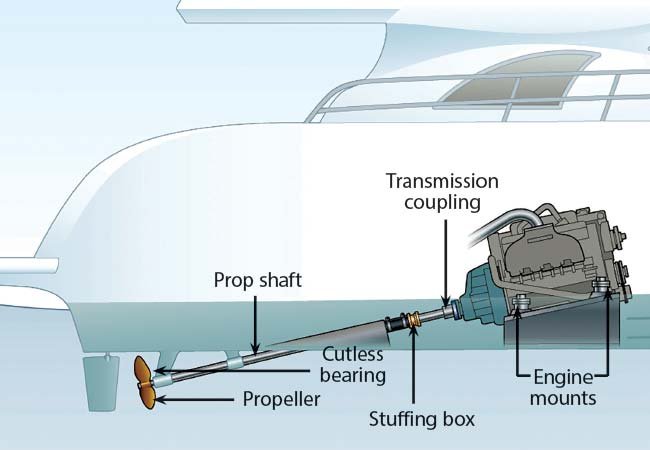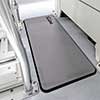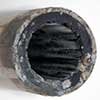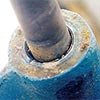Troubleshooting Boat Vibrations
By Mark Corke
 Illustration: Mark Franklin Arts
Illustration: Mark Franklin Arts
Vibrations may be good when listening to rock and roll, but unless you have the stereo pumping, anything causing vibrations is often indicative of an issue with a component on the boat.
Unwanted vibration is more than just a nuisance. If left unchecked, it could be doing significant damage to your boat. Often, the source of onboard vibration can be traced to problems with the engine and running gear. This guide is designed to help you track down and hopefully correct any problems in that arena. Because the parts in the drive train and running gear are interconnected, something that is worn or out of alignment puts extra stress on other components that may also suffer.
All boats vibrate to some extent when they're underway, and over time, you, the owner, will become attuned to your particular boat's characteristics. But if you become aware of something new, or it just does not feel (or sound) right, then it may be time to carry out some investigative work to find the culprit. Some vibrations emanating from something like an excessively worn engine mount, for instance, may produce a distinctive metallic sound, helping you home in on the problem. On the other hand, many vibrations have no distinctive or easy-to-source sounds, and although they may be felt, you can't hear them, making tracking down issues harder.
Steve Zimmerman, President of Zimmerman Marine, who runs four repair yards in Virginia, Maryland, and North Carolina, says that tracking down unwanted vibrations can be tricky. "We've found over the years that props are often the issue, but it can be something different entirely, you need to eliminate the easy things first and work from there."
When All Else Fails
>It's a great idea to make notes when the boat is running so that when you haul her from the water you can check for causes of vibrations that were previously experienced while the boat was underway. Look for worn areas under bearings and around the stuffing box. On some boats where there is a large section of the shaft visible, it may actually be possible to spot a bent shaft. Watch closely from different angles while you get a helper to turn the shaft slowly by hand.
When the boat isn't running, you can run your finger around the shaft where it enters the stuffing box and see if you can feel any wear, which could indicate an excessively worn shaft, a potential cause of shake and vibration. When it is hauled, damage to props is often easier to spot with the naked eye; look for dings, dents and gouges, even something seemingly inconsequential can throw things out of balance and cause vibration when the prop is rotating at high speed. You can do a basic check to make sure the blades are even by measuring the distance from each blade tip to the same spot on the hull or a block of wood placed directly under the boat.
In this guide, we are going to concentrate on inboard engines. That's not to say that outboards don't vibrate, because they do, but these are outside the scope of this article. Inboard engines have a lot of things attached to them, such as transmissions, reduction gears, propshafts, and propellers, all of which can be the cause of undue vibrations.
For this article, we are assuming there is only one engine. If you have twins, then it's often helpful to check one at a time. Sometimes having a pair of engines can be beneficial as it's possible to check one against the other. If one is noticeably different in operation to the other, then you'll want to find out why.
What follows is not a comprehensive guide by any stretch, but it will, hopefully, help you identify the source of any unwanted vibration, starting with the simplest causes. Once you've found the reason for the annoyance, you can do something about getting it fixed. And although you may not be in a position to carry out repairs yourself, your yard or mechanic will thank you if you can accurately describe and narrow down the source of any problems.
Decision Tree
Does the engine vibrate when it is running with transmission in neutral?
If Yes:
Worn engine mounts.
Inspect each engine mount in turn. Is one shaking more than the others? Is there excessive rusting or rubber residue adjacent top one or more of the mounts?
Remedy: Adjust or replace engine mounts.
Engine does not idle properly.
A rough-running engine can lead to excessive vibration. Run diagnostic checks in accordance with engine manufacturer's recommendations.
Remedy: Service or repair the engine.
Does the vibration occur only when the engine is in gear?
If Yes:
Fouled propeller.
Inspect propeller for rope, fishing line, weeds, or other fouling.
Remedy: Remove fouling and clean the propeller.
Bent, damaged, or missing propeller blade.
Carry out a visual inspection of the propeller.
Remedy: Repair or replace the damaged propeller.
Propeller not corrected fitted properly onto shaft.
Remove prop and check key, keyway, and taper for damage.
Remedy: Have the propeller lapped to the shaft to fit the taper correctly. Lap prop taper to ensure it fits correctly. Install new key.
Does the vibration increase or decrease at certain speeds?
If Yes:
Propeller may be out of balance.
Check prop with a dial gauge to ensure it is in round. On a sailboat with folding props, make sure that the blades open and seat correctly.
Remedy: Have the propeller serviced by a reputable propeller shop.
Cutless bearing is worn.
Grasp the prop and also grab the shaft near the bearing and try to shake/move it up and down and side to side with a lot of your strength. If there's discernable movement between the shaft and the inside of the cutless bearing then the bearing will need replacing, as it's worn. There should be zero fore and aft movement, which would be indicative of either a loose prop, a loose prop shaft coupling, or wear in the transmission.
Remedy: Replace the cutless bearing.
Is it hard to rotate the propeller by hand with the transmission in neutral?
If Yes:
Shaft may be bent.
If you suspect a bent shaft, have it inspected by a specialist facility.
Remedy: Remove shaft and have it straightened or replaced.
Propeller shaft strut out of alignment.
Check for visible cracking and twisting. Check mounting bolts for movement. Check hull around mounting bolts for vibration when you're running.
Remedy: Replace or repair strut.
Engine alignment poor.
Disconnect shaft from transmission. If shaft then turns easily, alignment issue is likely.
Remedy: Correct alignment between shaft and transmission.
Engine mounts may be worn and sagging.
Inspect each engine mount in turn.
Remedy: Adjust or replace mounts.
Is one shaking more than the others?
Is there excessive rusting or rubber residue adjacent top one or more of the mounts?
Remedy: Check and replace engine mounts.
Is there a visible wobble to the shaft inside the boat when operating at speed?
If Yes:
Coupling may be misaligned.
Separate coupling from transmission and check alignment.
Remedy: Adjust and/or replace engine mounts.
Engine mount(s) worn or improperly adjusted.
Inspect each engine mount in turn. Is one shaking more than the others? Is there excessive rusting or rubber residue adjacent to one or more of the mounts?
Remedy: Service, adjust, or replace engine mounts.
Shaft could be bent.
Specialist equipment is required to properly check for bent shaft.
Remedy: Remove shaft and have it straightened or replaced.
Transmission output flange distorted.
Specialist equipment is required to properly check for runout or defective coupling.
Remedy: Replace output flange.
Drivesaver, if fitted, is worn or damaged.
Remove Drivesaver from between shaft and transmission coupling and visually inspect for tears and distortion.
Remedy: Replace Drivesaver.
Congratulations! If you've made it this far, you should have been able to fix, or at least identify, the issue that was causing those unwanted vibrations. On the other hand, if you have not been able to isolate the issue, it may be a good time to seek expert help from a competent yard. But at least you gave it a shot, and hopefully you learned something about your boat along the way.
Finally, remember to keep your BoatUS towing membership up to date. Then, if things really get bad when you're out, you'll always be able to get safely back to your slip or dock.
— Published: October/November 2018
Recommended Articles
 Getting Rid Of Boat Vibrations
Getting Rid Of Boat VibrationsVibration-dampening gear that will help keep you from feeling worn out after a day on the water
 Bad Vibrations
Bad VibrationsVibrations can come from problems ranging from small to huge to potentially catastrophic
 Your Pre-Launch Checklist
Your Pre-Launch ChecklistBefore you head out, run through this countdown to make sure all systems are a go
![]()
BoatUS Magazine Is A Benefit Of BoatUS Membership
Membership Also Provides:
- Subscription to the print version of BoatUS Magazine
- 4% back on purchases from West Marine stores or online at WestMarine.com
- Discounts on fuel, transient slips, repairs and more at over 1,000 businesses
- Deals on cruises, charters, car rentals, hotel stays and more ...
- All For Only $24 A Year!
